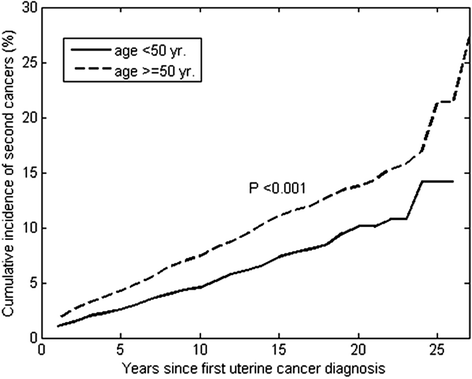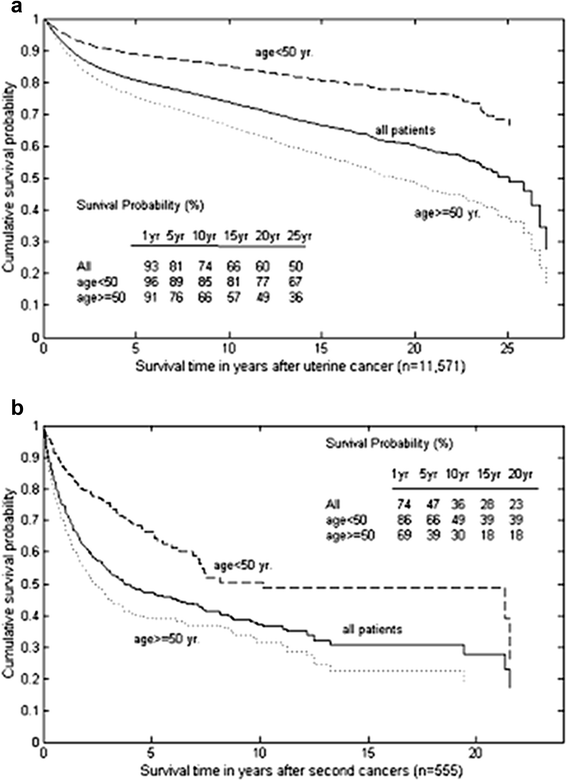Increased risk of second primary malignancies following uterine cancer: a population-based study in Taiwan over a 30-year period
- PMID: 25957789
- PMCID: PMC4469104
- DOI: 10.1186/s12885-015-1426-3
Increased risk of second primary malignancies following uterine cancer: a population-based study in Taiwan over a 30-year period
Abstract
Background: Previous studies assessing second primary malignancies (SPMs) after uterine cancer have been conducted in Western populations with conflicting results. This study aimed to define the incidence and risk of SPMs in Taiwanese patients with an initial diagnosis of uterine cancer.
Methods: Using population-based data from the Taiwan Cancer Registry for the period 1979-2008, we quantified standardized incidence ratios (SIRs) among 11,571 women with an initial diagnosis of uterine cancer.
Results: Among the 11,571 women, 555 (4.80%) developed at least one SPM during 69,987 person-years of follow-up. There was a 71% increased risk of SPM following uterine cancer (SIR=1.71, 95% CI, 1.57-1.86), with higher risks in the vagina/vulva (SIR=9.06), small intestine (SIR=8.45), ovary (SIR=4.15), urinary bladder (SIR=2.31), kidney (SIR=2.24), colorectum (SIR=2.24), lung (SIR=1.96), and breast (SIR=1.43). The risk of SPM was found to be the highest within the first 5 years after diagnosis of uterine cancer, with surveillance bias possibly contributing to the extremely high risk observed in the first follow-up year. The overall risk and pattern of SPM development observed in this study differed from those previously reported in Western populations, possibly because of the methodology and shorter follow-up period employed in this study. The cumulative incidence of SPMs was significantly higher in older patients (≥50 years) than in younger patients (P<0.001).
Conclusions: To our knowledge, this is the first study in an Asian population to report 71% increased risk in SPMs in women previously diagnosed with uterine cancer. A younger age at diagnosis of uterine cancer conferred an increased risk of second malignancies, and SPMs worsened survivorship in patients who survived uterine cancer.
Figures
Similar articles
-
Second primary malignancies following thyroid cancer: a population-based study in Taiwan.Eur J Endocrinol. 2013 Oct 1;169(5):577-85. doi: 10.1530/EJE-13-0309. Print 2013 Nov. Eur J Endocrinol. 2013. PMID: 23939917
-
Increased risk of second primary malignancies in patients with gynecological cancer. A Swedish record-linkage study.Acta Oncol. 1995;34(6):771-7. doi: 10.3109/02841869509127185. Acta Oncol. 1995. PMID: 7576744
-
Risk of second primary malignancies in women with cervical cancer: a population-based study in Taiwan over a 30-year period.Gynecol Oncol. 2012 Dec;127(3):625-30. doi: 10.1016/j.ygyno.2012.09.004. Epub 2012 Sep 10. Gynecol Oncol. 2012. PMID: 22975362
-
Risks of second non-breast primaries following breast cancer in women: a systematic review and meta-analysis.Breast Cancer Res. 2023 Feb 10;25(1):18. doi: 10.1186/s13058-023-01610-x. Breast Cancer Res. 2023. PMID: 36765408 Free PMC article.
-
Incidence of Second Primary Malignancies in Patients with Neuroendocrine Tumours.Neuroendocrinology. 2015;102(1-2):26-32. doi: 10.1159/000381716. Epub 2015 Mar 21. Neuroendocrinology. 2015. PMID: 25824138 Review.
Cited by
-
The bidirectional association among female hormone-related cancers: breast, ovary, and uterine corpus.Cancer Med. 2018 Jun;7(6):2299-2306. doi: 10.1002/cam4.1473. Epub 2018 Apr 16. Cancer Med. 2018. PMID: 29659167 Free PMC article.
-
Risk of second primary breast cancer among cancer survivors: Implications for prevention and screening practice.PLoS One. 2020 Jun 4;15(6):e0232800. doi: 10.1371/journal.pone.0232800. eCollection 2020. PLoS One. 2020. PMID: 32497148 Free PMC article.
-
Analysis and prediction of second primary malignancy in patients with breast cancer.Mol Clin Oncol. 2022 Oct 24;17(6):160. doi: 10.3892/mco.2022.2593. eCollection 2022 Dec. Mol Clin Oncol. 2022. PMID: 36381252 Free PMC article.
-
Increased risk of subsequent primary lung cancer among female hormone-related cancer patients: A meta-analysis based on over four million cases.Chin Med J (Engl). 2024 Aug 5;137(15):1790-1801. doi: 10.1097/CM9.0000000000003132. Epub 2024 Jul 8. Chin Med J (Engl). 2024. PMID: 38973242 Free PMC article.
-
The association between histological subtype of a first primary endometrial cancer and second cancer risk.Int J Gynecol Cancer. 2019 Feb;29(2):290-298. doi: 10.1136/ijgc-2018-000014. Epub 2018 Dec 21. Int J Gynecol Cancer. 2019. PMID: 30718311 Free PMC article.
References
Publication types
MeSH terms
LinkOut - more resources
Full Text Sources
Other Literature Sources
Medical



